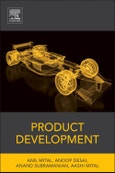Product development teams are composed of an integrated group of professionals working from the nascent stage of new product planning through design creation and design review and then on to manufacturing planning and cost accounting. An increasingly large number of graduate and professional training programs are aimed at meeting that need by creating a better understanding of how to integrate and accelerate the entire product development process. This book is the perfect accompaniment and a comprehensive guide.
The second edition of this instructional reference work presents invaluable insight into the concurrent nature of the multidisciplinary product development process. It can be used in the traditional classroom, in professional continuing education courses or for self-study. This book has a ready audience among graduate students in mechanical and industrial engineering, as well as in many MBA programs focused on manufacturing management. This is a global need that will find a receptive readership in the industrialized world particularly in the rapidly developing industrial economies of South Asia and Southeast Asia.
- Reviews the precepts of Product design in a step-by-step structured process and focuses on the concurrent nature of product design
- Helps the reader to understand the connection between initial design and interim and final design, including design review and materials selection
- Offers insight into roles played by product functionality, ease-of assembly, maintenance and durability, and their interaction with cost estimation and manufacturability through the application of design principles to actual products
Table of Contents
1. The Significance of Manufacturing2. Developing Successful Products
3. The Structure of the Product Design Process
4. Design Review: Designing to Ensure Quality
5. Consideration and Selection of Materials
6. Selection of Manufacturing Processes and Design Considerations
7. Designing for Assembly and Disassembly
8. Designing for Maintenance
9. Designing Products for Functionality
10. Design for Usability
11. Concurrent Consideration of Usability and Functionality
12. Establishing the Product Selling Price
13. Assessing the Market Demand for the Product








